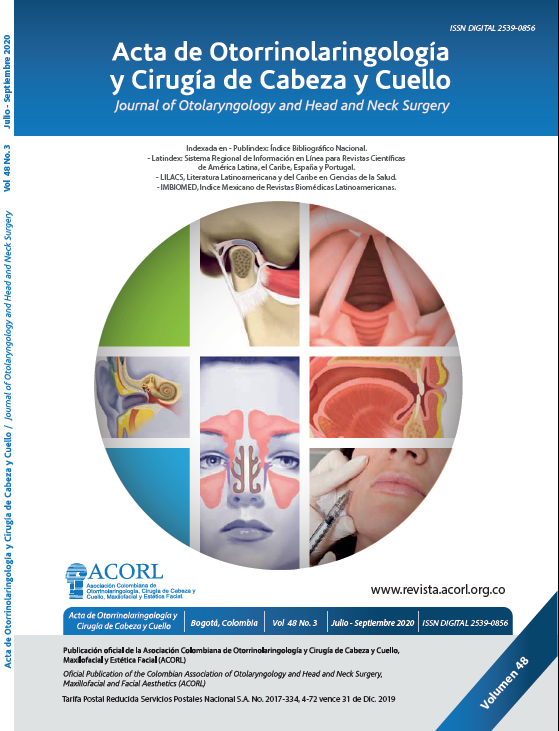Resultados audiológicos y de calidad de vida en pacientes con transición del sistema Baha Connect® a Baha Attract®
Contenido principal del artículo
Resumen
Introducción: los implantes auditivos de conducción ósea percutáneos han sido usados de forma exitosa. Sin embargo, un número importante de pacientes reportan reacciones en piel repetitivas. Los implantes auditivos transcutáneos son una alternativa que pueden solventar estas complicaciones. Con este estudio queremos describir los resultados audiológicos y de calidad de vida en pacientes que requirieron transición del sistema percutáneo a transcutáneo.Metodología: estudio observacional descriptivo, se incluyeron pacientes con implante auditivo percutáneo que requirieron transición a sistema transcutáneo. Se evaluó el desempeño auditivo utilizando una prueba con fondo ruidoso y se aplicó la escala de calidad de vida “Glasgow Benefit Inventory”-GBI.
Detalles del artículo
Sección

Esta obra está bajo una licencia internacional Creative Commons Atribución-CompartirIgual 4.0.
Este artículo es publicado por la Revista Acta de Otorrinolaringología & Cirugía de Cabeza y Cuello.
Este es un artículo de acceso abierto, distribuido bajo los términos de la LicenciaCreativeCommons Atribución-CompartirIgual 4.0 Internacional.( http://creativecommons.org/licenses/by-sa/4.0/), que permite el uso no comercial, distribución y reproducción en cualquier medio, siempre que la obra original sea debidamente citada.
eISSN: 2539-0856
ISSN: 0120-8411
Cómo citar
Referencias
Snik AF, Mylanus EA, Proops DW, Wolfaardt JF, Hodgetts WE, Somers T, et al. Consensus statements on the BAHA system: where do we stand at present?. Ann Otol Rhinol Laryngol Suppl. 2005;195:2-12. doi:10.1177/0003489405114s1201
Verstraeten N, Zarowski AJ, Somers T, Riff D, Offeciers EF. Comparison of the audiologic results obtained with the boneanchored hearing aid attached to the headband, the testband, and to the “snap” abutment. Otol Neurotol. 2009;30(1):70-75. doi:10.1097/MAO.0b013e31818be97a
Kruyt IJ, Bakkum KHE, Caspers CJI, Hol MKS. The efficacy of bone-anchored hearing implant surgery in children: A systematic review. Int J Pediatr Otorhinolaryngol. 2020;132:109906.doi:10.1016/j.ijporl.2020.109906
Kim G, Ju HM, Lee SH, Kim HS, Kwon JA, Seo YJ. Efficacy of Bone-Anchored Hearing Aids in Single-Sided Deafness: A Systematic Review. Otol Neurotol. 2017;38(4):473-483.doi:10.1097/MAO.0000000000001359
Dun CA, de Wolf MJ, Mylanus EA, Snik AF, Hol MK, Cremers CW. Bilateral bone-anchored hearing aid application in children: the Nijmegen experience from 1996 to 2008. Otol Neurotol. 2010;31(4):615-623. doi:10.1097/MAO.0b013e3181dbb37e
Shapiro S, Ramadan J, Cassis A. BAHA Skin Complications in the Pediatric Population: Systematic Review With Metaanalysis. Otol Neurotol. 2018;39(7):865-873. doi:10.1097/MAO.0000000000001877
Verheij E, Bezdjian A, Grolman W, Thomeer HG. A Systematic Review on Complications of Tissue Preservation Surgical Techniques in Percutaneous Bone Conduction Hearing Devices. Otol Neurotol. 2016;37(7):829-837. doi:10.1097/MAO.0000000000001091
Dun CA, Faber HT, de Wolf MJ, Mylanus EA, Cremers CW, Hol MK. Assessment of more than 1,000 implanted percutaneous bone conduction devices: skin reactions and implant survival. Otol Neurotol. 2012;33(2):192-198. doi:10.1097/MAO.0b013e318241c0bf
Pross SE, Layton A, Tong K, Lustig LR. Cost of placement and complications associated with osseointegrated bone-conducting hearing prostheses: a retrospective analysis of medicare billing data. Otol Neurotol. 2014;35(3):476-481. doi:10.1097/ MAO.0b013e31829ce78d
Kiringoda R, Lustig LR. A meta-analysis of the complications associated with osseointegrated hearing aids. Otol Neurotol. 2013;34(5):790-794. doi:10.1097/MAO.0b013e318291c651
de Wolf MJ, Hol MK, Huygen PL, Mylanus EA, Cremers CW. Clinical outcome of the simplified surgical technique for BAHA implantation. Otol Neurotol. 2008;29(8):1100-1108. doi:10.1097/MAO.0b013e31818599b8
Flynn M. Design concept and technological considerations for the Cochlear BAHA 4 Attract System. Report E82744. 2013;1-7.
Carr SD, Bruce IA, Jones D, Ray J. Outcomes following conversion of a percutaneous to a transcutaneous bone
conduction device in eight children. Clinical Otolaryngology. 2017;42:917–20. doi: 10.1111/coa.12828
Cedars E, Chan D, Lao A, Hardies L, Meyer A, Rosbe K. Conversion of traditional osseointegrated bone-anchored hearing aids to the Baha® attract in four pediatric patients. Int J Pediatr Otorhinolaryngol. 2016;91:37-42. doi:10.1016/j.ijporl.2016.09.033
Gawęcki W, Stieler OM, Balcerowiak A, Komar D, Gibasiewicz R, Karlik M, Szyfter-Harris J, Wróbel M. Surgical, functional and audiological evaluation of new Baha(®) Attract system implantations. Eur Arch Otorhinolaryngol. 2016;273(10):3123- 30. doi: 10.1007/s00405-016-3917-5
Iseri M, Orhan KS, Tuncer U, Kara A, Durgut M, Guldiken Y, et al. Transcutaneous Bone-anchored Hearing Aids Versus Percutaneous Ones: Multicenter Comparative Clinical Study. Otol Neurotol. 2015;36(5):849-53. doi: 10.1097/MAO.0000000000000733
Sanchez-Cuadrado I, Lassaletta L, Perez-Mora R, Muñoz E, Gavilan J. Reliability and validity of the Spanish Glasgow Benefit Inventory after cochlear implant surgery in adults. Eur Arch Otorhinolaryngol. 2015;272(2):333-336. doi:10.1007/s00405-013-2844-y
Robinson K, Gatehouse S, Browning GG. Measuring patient benefit from otorhinolaryngological surgery and
therapy. Ann Otol Rhinol Laryngol. 1996;105(6):415-422. doi:10.1177/000348949610500601
Kraai T, Brown C, Neeff M, Fisher K. Complications of bone-anchored hearing aids in pediatric patients. Int J Pediatr Otorhinolaryngol. 2011;75(6):749-753. doi:10.1016/j.ijporl.2011.01.018
Ordóñez-Ordóñez LE, Rey TG, Angulo-Martínez ES, Rodríguez SR, Vanegas SC and Guzmán Durán JE. Abstract:
Clinical Experience with Sophono Alpha 2 MPO™ in Conductive, Mixed and Sensorineural Hearing Losses Patients. J Otolaryngol ENT Res. 2017;9(2):00279. doi: 10.15406/joentr.2017.09.00279.
Bezdjian A, Bruijnzeel H, Daniel SJ, Grolman W, Thomeer HGXM. Preliminary audiologic and peri-operative outcomes of the Sophono™ transcutaneous bone conduction device: A systematic review. Int J Pediatr Otorhinolaryngol. 2017;101:196-203. doi:10.1016/j.ijporl.2017.08.014
Zernotti ME, Di Gregorio MF, Galeazzi P, Tabernero P. Comparative outcomes of active and passive hearing devices by transcutaneous bone conduction. Acta Otolaryngol. 2016;136(6):556-558. doi:10.3109/00016489.2016.1143119
Sharma S, Reddy-Kolanu G, Marshall AH. UK tertiary centre experience of outcomes from osseointegrated transcutaneous magnetic bone conduction hearing system implanted in twentyfive patients using a linear incision technique. Clin Otolaryngol. 2017;42(5):1041-1043. doi:10.1111/coa.12815
Lau K, Scotta G, Wright K, Proctor V, Greenwood L, Dawoud M, et al. First United Kingdom experience of the novel Osia active transcutaneous piezoelectric bone conduction implant. Eur Arch Oto-Rhino-Laryngology. 2020. doi: 10.1007/s00405-020-06022-7
Hendry J, Chin A, Swan IR, Akeroyd MA, Browning GG. The Glasgow Benefit Inventory: a systematic review of the use and value of an otorhinolaryngological generic patient-recorded outcome measure. Clin Otolaryngol. 2016;41(3):259-75. doi:10.1111/coa.12518.
Arunachalam PS, Kilby D, Meikle D, Davison T, Johnson IJ. Bone-anchored hearing aid quality of life assessed by Glasgow Benefit Inventory. Laryngoscope. 2001;111(7):1260-1263.doi:10.1097/00005537-200107000-00022





